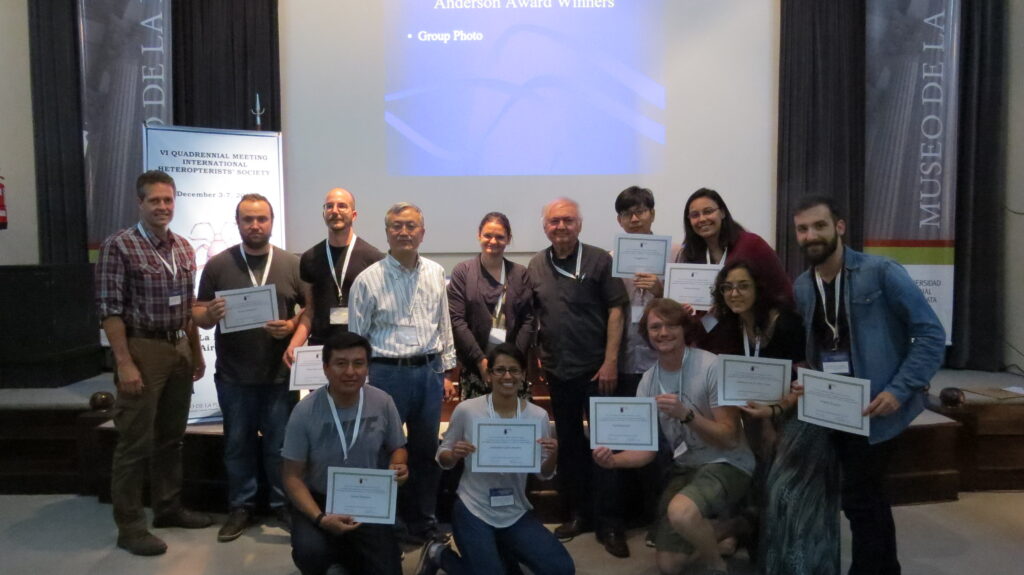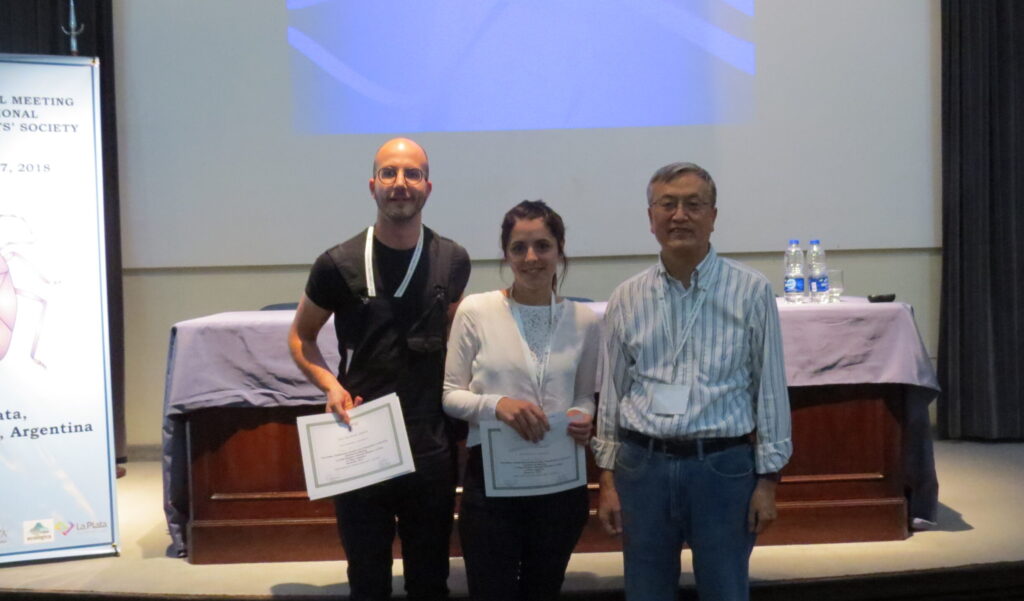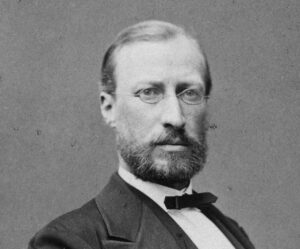IHS Awards
The IHS has several awards
The Nils & Annemarie Møller Andersen Travel Award was established in 2005 by Annemarie Møller Andersen in memory of her husband, Nils Møller Andersen, an internationally renowned Danish heteropterist and a charter member of the International Heteropterists’ Society. The award provides financial assistance to help young heteropterists travel to the Quadrennial Meeting of the Society and present research in the form of a poster or paper presentation. Eligible researchers include those who have completed a thesis or dissertation on Heteroptera within the last five years or students who are currently enrolled in a university and working toward an advanced degree in some aspect of heteropteran biology and/or systematics.
Applications will be reviewed by a committee composed of the IHS President, President-Elect, and Program Chair. Either partial or full travel grants may be awarded.
Awardees
The following people are previous recipients of a Nils & Annemarie Møller Andersen Award:
Seventh Quadrennial Meeting 2022
- Alex Knudson, University of North Dakota, USA.
- Stephanie Castillo, University of California, USA.
- Eugenia Minghetti, Universidad Nacional de la Plata, Argentina.
- Leonela Olivera, Universidad Nacional de la Plata, Argentina.
- Pablo Varela, Universidad Nacional de la Plata, Argentina.
- Joanna Zygala, University of Silesia, Poland.
- Leticia Nery, University of Federal Rural de Janeiro, Brazil.
- Swapnil S. Boyane, Ashoka Trust for Research in Ecology and the Environment (ATREE), India.
Sixth Quadrennial Meeting 2018
- Arthien Lovell Pelingen, Department of Biology, Quezon City, Philippines. Heteroptera research in Southeast Asia: What has been done and current gaps
- Bruno Genevcius, Museum of Zoology, São Paulo, Brazil. Developmental and functional roles in the evolution of stink bug
- Cassina Furlan Lopez, Universidade Federal do Pampa, Rio Grande do Sul, Brazil. Sexual dimorphism in hind legs of Belostoma angustum Lauck (Insecta, Heteroptera, Belostomatidae) may be related to paternal care
- Daniel Reynoso-Velasco, Red de Biodiversidad y Sistemática, Veracruz, Mexico. Classification of the Cryphocricinae Montandon (Hemiptera: Heteroptera: Naucoridae): Reconsiderations based on molecular phylogenetics
- Junggon Kim, Laboratory of Systematic Entomology, Daejeon, Korea. Phylogeny of the plant bug subfamily Mirinae (Hemiptera: Heteroptera: Cimicomorpha: Miridae) based on total-evidence
- Marco Roca-Cusachs, Laboratory of Systematic Entomology, Daejeon, Korea. Molecular phylogeny of the stink bug family Pentatomidae (Hemiptera: Heteroptera)
- Paul Masonick, Department of Entomology, California, USA. Integrative species delimitation in Nearctic ambush bugs (Heteroptera: Reduviidae): Insights from geometric morphometrics, molecules, and ecological associations
- Ricardo Brugnera, Universidade Federal do Rio Grande do Sul, Rio Grande do Sul, Brazil. Podisus Herrich-Schaeffer 1851, the taxonomic dumping ground of Asopinae (Heteroptera: Pentatomidae): actual knowledge and perspectives
- Tamara Moraes, University of São Paulo, São Paulo, Brazil. Morphological and genetic diversity of the green-belly stink bugs Dichelops spp. (Heteroptera: Pentatomidae)
- Valentina Castro-Huertas, Laboratório de Entomologia Sistemática, Rio Grande do Sul, Brazil. Cladistic analysis and character evolution of the thread-legged bugs of the tribe Metapterini Stål, 1859 (Hemiptera, Reduviidae, Emesinae) based on morphological characters
- Wanessa da Silva Costa, Universidade Federal do Rio Grande do Sul, Rio Grande do Sul, Brazil. Cladystic analysis of Spartocerini Amyot & Serville, 1843 (Hemiptera, Heteroptera, Coreidae)
- Filipe Bianchi, Laboratório de Entomologia Sistemática, Rio Grande do Sul, Brazil. Niche shift of the invasive pest Bagrada bug: a global threat to agricultural systems from now to the future.
- Marcelo Reginato Paim, Departamento de Zoologia, Rio Grande do Sul, Brazil. The taxonomic value of the female genitalia in Euschistus (Euschistus) Dallas, 1851
Fifth Quadrennial Meeting 2014
- Michael Forthman, University of California Riverside, California, USA. The systematics of the endemic Millipede Assassin Bugs of Madagascar (Heteroptera: Reduviidae: Ectrichodiinae).
- Christiane Bramer, Biozentrum Grindel und Zoologisches Museum, Hamburg, Germany. Evolution of adapatations in specialized Lygaeinae (Heteroptera, Lygaeidae).
- Shruti Paripatyadar, Abasaheb Garware College, Maharashtra, India. Aquatic and semi-aquatic Heteroptera of Western Ghats of Maharashtra, India revisited.
- Irina Morales-Castaño, Universidades Federal de Vicosa, Museu Regional do Entomologia, Minas Gerais, Brazil. Systematics of the genus Collaria (Hemiptera: Miridae): taxonomy, genitalic morphology and geographic distribution.
- Eduardo Faúndez, North Dakota State University, North Dakota, USA. Preliminary results on the tribe Aeptini (Hemiptera: Pentatomidae: Pentatominae).
- Marion Carvajal, North Dakota State University, North Dakota, USA. Studies on the Acanthosomatid spermatheca: preliminary results.
- Eric Gordon, University of California Riverside, California, USA. Evolution of the Termite Assasin Bugs: Salyavatinae and Sphaeridopinae (Hemiptera: Reduviidae).
Fourth Quadrennial Meeting 2010
- Ondrej Balvín, Charles University, Prague, Czech Republic. Mitochondrial and morphological diversity in the bed bug Cimex lectularius (Heteroptera: Cimicidae) on different hosts
- Pablo Matías Dellapé, Museo de La Plata, La Plata, Argentina. A phylogenetic review of Neopamera Harrington 1980 (Hemiptera: Rhyparochromidae: Myodochini), with the description of new genera and species.
- Tomáš Ditrich, University of South Bohemia, Ceské Budejovice, Czech Republic. Extraordinary life history in semiaquatic bugs: case of Velia caprai.
- María Cecilia Melo, Universidad Nacional de La Plata, Buenos Aires, Argentina. The aquatic and semiaquatic Heteroptera (Hemiptera) from Argentina.
- Anna Namyatova, St. Petersburg State University, St. Petersburg, Russia. Review of the genus Globiceps Le Peletier & Serville, 1825 (Heteroptera: Miridae)
Third Quadrennial Meeting 2006
- Dominik Chlond, University of Silesia, Katowice, Poland. Heteropteran terrestrial bugs of the Ojcowsky National Park – origin of fauna (Hemiptera: Heteroptera)
- Dimitri Gapon, Zoological Institute R.A.S. St. Petersburg, Russia. Relationship of genera within the subfamily Asopinae (Pentatomidae)
- Anna Namyatova, St. Petersburg State University, St. Petersburg, Russia. Diagnostic characters of Leptoceraea viridis Jakovlev, 1873 and L. femoralis (Horvath, 1897) and distribution of these species in the former USSR and adjacent countries (Heteroptera: Rhopalidae).
- Christiano Schwertner, UFRGS, Porto Alegre, Brazil
On the monophyly of the genus Chinavia (Hemiptera, Pentatomidae, Pentatominae) and its phylogenetic position among related genera. - Quiang Xie, Nankai University, Tianjin, China
18SrRNA Hyper-elongation and the Phylogeny of Euhemiptera (Insecta: Hemiptera)
The Stål Lifetime Achievement Award (after Carl Stål), given once every four years at the IHS Quadriennial Meeting, represents a pinnacle of achievement in Heteropterology and the highest award given to a member of the Society in the form of an engraved medal. Nominations will be evaluated by the Executive Committee and the award will be given at the quadrennial IHS meeting as part of the ceremonies at the closing business meeting. The winner will be announced prior to the meeting.
Nomination packets should consist of 1) a nomination letter no longer than 5 pages that addresses the nominee’s qualifications based on the award criteria listed below and 2) the nominee’s CV that includes a list of publications.
- Publication quality and impact: Quality of publications will be assessed in part by the impact of the journal and number of citations. Impact will also be assessed by the novelty of the findings, scientific merit, and if publications have served as a benchmark for future studies.
- Publication output: The number of publications over the life-to-date of a researcher will be a key selection criterion. This also will take into account career interruptions, including teaching loads and other non-output activities.
- Student and staff mentoring: This criterion will allow for assessment of those researchers that have had a significant role in training the next generation of heteropterists. This could include undergraduate and postgraduate students, research assistants, and visiting scientists.
- Contributions to heteropteran collections: In the case of systematic heteropterists, the role that researchers have played in building and curating collections will be assessed. This will take into account the unique role that museum-based heteropterists have had in building the discipline.
- Contributions to the Society: The role of researchers in developing and promoting the Society will be taken into account, including service in executive and non-executive roles.
Nomination should be submitted to the IHS Secretary by the given date before each meeting.
Awardees
Seventh Quadrennial Meeting. Barcelona, España 2022
- Thomas J. Henry. Systematic Entomology Laboratory, Smithsonian Institution, National Museum Natural History, Washington DC, USA
Sixth Quadrennial Meeting. La Plata, Argentina 2018
- Randall T. Schuh, Division of Invertebrate Zoology, American Museum of Natural History, New York, USA.
The Kerzhner Awards, named in honor of the renowned late Russian heteropterist, Izya M. Kerzhner, are given for the outstanding student oral and poster presentation at each meeting. Students should indicate when submitting papers or posters that they wish to participate. Presentations are judged by the Executive Committee and winners are announced at the final business meeting. Each award is for $200.
Awardees
Seventh Quadrennial Meeting, Barcelona, Spain 2022
- Andrian Masłowski, Poster presentation: Comparative studies of sensory organs on the legs of representatives of plant bugs (Hemipera: Heteroptera: Miridae).
- Leticia Nery, University of Federal Rural de Janeiro, Brazil. Poster presentation: Priority areas for the conservation of semiaquatic bugs (Heteroptera: Gerromorpha) in Alagoas and Sergipe States, Northeastern Brazil.
- Stephanie Castillo, University of California, USA. Talk presentation: Investigating the evolutionary history of the corsairs (Heteroptera: Reduviidae)
- Sang Yun Bang, talk presentation: Two alternative mechanisms of thrust generation by a midleg stroke in semiaquatic bugs: comparison of leg kinematics in Gerris latiabdominis and Rhagovelia distincta.
Sixth Quadrennial Meeting, La Plata, Argentina 2018
- Marcos Roca-Cusachs, Laboratory of Systematic Entomology, Daejeon, Korea. Molecular phylogeny of the stink bug family Pentatomidae (Hemiptera: Heteroptera)
- Leonela Olivera, Museo de La Plata, La Plata, Argentina. Leptoglossus clypealis (Heidemann) (Heteroptear: Coreidae) a potential global invader: use of ecological niche modeling to predict possible current and future worldwide distributions






